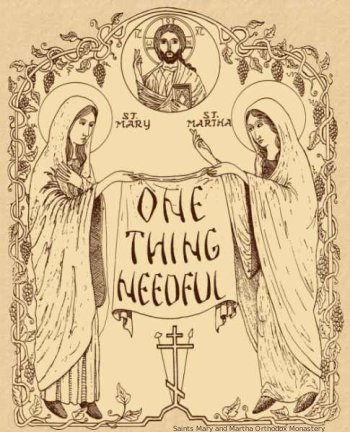
Jesus' Love for All of Us
In reading about the life of Dionysios the Areopagite, we came across his account of his meeting the priest Karpos on the island of Crete. Desiring to instruct the monk Demophilos, Dionysios included this narrative in his letter to him to show that Christ desires love and mercy and conversion, rather than judgment and condemnation.
"After I had arrived in Crete," says the wise Dionysios in one of his writings, "the priest Karpos showed me hospitality. He was such a virtuous man and of such a clear intellect that he never began the Divine Liturgy without previously seeing a vision. This wonderful priest related to me that a certain infidel had vexed him. In that he had separated a devout Christian from the faith and turned him into an atheist. As he was embittered, he did not invoke God in good will to assist and bring back the wayward one to piety through admonition, but instead the resentment persisted in his soul as he lay down to sleep in indignation and anger. At midnight, he arose to recite the divine hymns as was his custom, and, as he prayed, he was sore distressed, reasoning that it was not just for atheists to live, for they distort the ways of God. As he pondered these matters, he besought God to cast down thunder from heaven and smite without pity.
"As he meditated on these matters, suddenly it seemed that the whole house shook violently. Then, it was riven apart from the top to the foundations, and fire descended from heaven down to him. The heavens opened, and Jesus sat at the very top, surrounded by countless angels in human guise. Seeing this, he marveled, but as he looked downward, he noticed that the surface of the earth was torn asunder. At the edge of the abyss he beheld the two men he had cursed, standing in terror and in danger of falling into it as the earth quaked beneath their feet. From that fissure crept serpents which writhed about their feet, and at times hissed at them, and smote them with their tails, attempting to push them over; and thus, they were in grave danger. Now when Karpos saw them, he was distressed that they were not swallowed up! He then lifted his eyes to heaven and beheld the Lord Christ, Who arose from His throne and descended with the angels who were aiding those two extending to them a hand, lest they should fall. Then Christ stretched forth His hand and said to Karpos, ‘Strike me too, O Karpos, for thou hast no pity for thy brethren. I am ready to suffer many times again for the salvation of mankind, and I am content if men but refrain from sin. But behold! Think well, lest thou shouldest prefer to forfeit the communion of God and the man-loving angels for the company of the serpents in that dark pit!'"
The Great Synaxaristes of the Orthodox Church, October, Holy Apostles Convent & Dormition Skete, Buena Vista, Colorado, 2002, pgs. 51-52.

ONE THING NEEDFUL
FALL 2015 & Winter 2016
MONASTERY NEWS
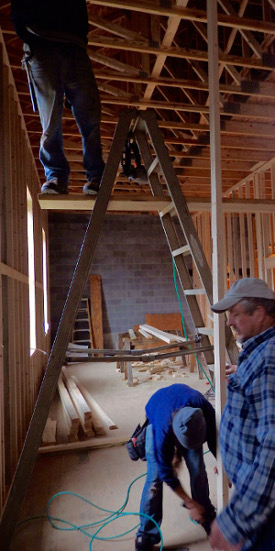
This newsletter is so late, that all of you need an explanation. The writer of this newsletter has been experiencing what is called diabetic macular degeneration for some time and is currently undergoing treatment which now enables her to read and write again. We are most heartened by those of you who have commented on our building project and ask when they will receive the next newsletter.
The progress on the building has come to a crawl as we save up to pay for the next step which is proving to be more costly than expected. So what's new!!! In early August, a crew came and filled in the outdoor, metal steps to the second floor with concrete that matched the red brick. Then we realized we had enough money to frame in the sacristy area and the rooms upstairs. When we let our busy contractor know this, we found ourselves on the framers' five-month waiting list. Due to the weather, rain mostly, they finally framed in the rest of the interior on January 26-28. Now we have a better vision of what the rooms will look like, which, as it so happened, brought us to a problem. The wall of one of the upstairs bathrooms ended one foot into a window due to a miscalculation (not the framers' fault). For a while, we thought that we would have to move the window, not something anyone wants to do on a brick and concrete block building even though it can be done. In showing a visitor the building as well as the problem, she simply said, "Why don't you move the bathroom wall back a foot?" That was a "Wow! I could have had a V8" moment. We've been told by people who have been involved in building projects, both home and commercial, that these kinds of problems are normal and to be expected.
Since we are considered a church and a monastery, we are literally overwhelmed by building regulations. While we would have liked to have built the whole building at once, we realize that only having the money to get this far was God's way of slowing us down to work out problems and make better decisions that will positively affect the entire project.
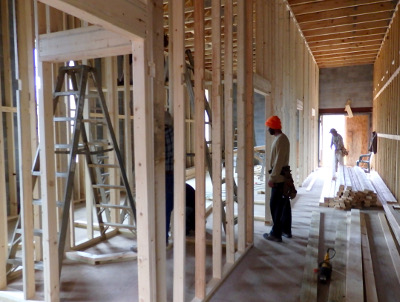
Currently, we've given the go ahead on ordering and installing stainless steel vents and crawl space doors. They will be primed and painted a color to match the brick. This will give three sides of the building a more finished look.
In obtaining quotes for roughing in the electrical, heating/air conditioning (HVAC), and plumbing, we heard the numbers in utter disbelief. Once again, we reminded ourselves that God is in charge. We have to remain faithful, practice patience, and keep doing what He gives us the ability to do towards this goal. "So, what are the quotes," you say. Electrical estimates will be forth coming in the next week or two. The HVAC estimate is $93,500 which includes some of the equipment. Roughing in the plumbing is around $50,000. Remember, this is a big project, and we're paying when we have the money to pay for it.
Whenever we give tours of our monastery and arrive at the chapel, we explain that we had hurricane windows installed to protect the future stained glass windows. They will be done in an iconographic style and portray Saint Anna with the Theotokos, Saint Martha of Bethany, Saint Mary of Bethany, Saint Thecla, Equal to the Apostles, Saint Lyubov of Rayzan, Fool for Christ, and Saint Olga of Alaska One of our visitors seriously said, "Find out how much they cost, I'd like to buy all of them." Little did she know how expensive stained glass windows are.
This request led to our praying for someone local who could paint and fire stained glass. By God's grace, we found a talented stained glass artist in North Augusta, South Carolina. Gathering prints of the saints listed above along with accounts of their lives, Mother Thecla arranged a meeting with Brenda Verdery-Devaney, the artist. A few weeks later, she called me with a price of $8500 per window. Then, we called the woman wanting to purchase the windows. She chose Saint Olga of Alaska.
A few months later, Brenda had a drawing to scale from which we have been working. Unfortunately, one of her workers and friend of many years became seriously ill and died. Then Mother Thecla was having trouble seeing. So we didn't get back to this project until the first part of February. With a few changes to the drawing, we started making decisions on which types and colors of stained glass to use. Now we are waiting for Brenda to create a water color drawing based on the glass that is available.
We know that the walls in the chapel are only framed in and have much to do before those walls are plastered over. Our contractor has already stated, "I'll board over the stained glass windows before workmen get in there."
Also, we are collecting for the remaining windows and have $3000 for Saint Martha of Bethany with an additional $600 for whomever.
Speaking of stained glass, we were given a sizable amount of it. Some of which may be used for this project.
From July 20-24, the All American Council of the Orthodox Church in America met
in Atlanta, Georgia. That was great for us, since it is a three to four hour drive from
the monastery. 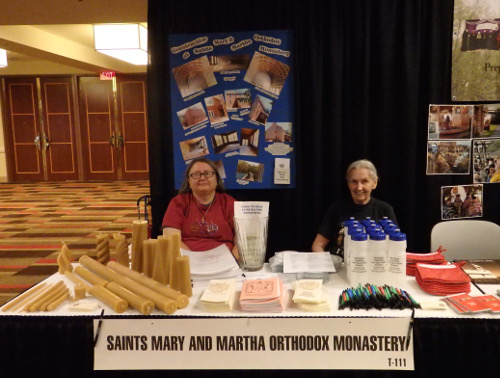 With there being two of us, Mother Helena remained at the
monastery and kept the prayers, candle making business, and whatever else was
needed going while Mother Thecla worked a display table for our monastery in the
vendors' room. Over the course of five days, many people whom we have met and
known over the years stopped by to visit. As always, there were numerous new faces
and new stories about what God has done and is doing and how the Orthodox
Church is growing. It was an honor to meet Saint Olga of Alaska's granddaughter
who is also named Olga and is a priest's wife like her grandmother. We are incredibly
grateful to those who helped work the display table and provided promotional items
to help people remember that we are here and to pray for us. If only we had ten
dollars for everyone that said, "I didn't know there was a monastery in South
Carolina!"
With there being two of us, Mother Helena remained at the
monastery and kept the prayers, candle making business, and whatever else was
needed going while Mother Thecla worked a display table for our monastery in the
vendors' room. Over the course of five days, many people whom we have met and
known over the years stopped by to visit. As always, there were numerous new faces
and new stories about what God has done and is doing and how the Orthodox
Church is growing. It was an honor to meet Saint Olga of Alaska's granddaughter
who is also named Olga and is a priest's wife like her grandmother. We are incredibly
grateful to those who helped work the display table and provided promotional items
to help people remember that we are here and to pray for us. If only we had ten
dollars for everyone that said, "I didn't know there was a monastery in South
Carolina!"
For the fourth year running, we had a group of girls with chaperones from Exaltation of the Holy Cross Orthodox Church in Greensboro, North Carolina. Each summer, they make coming here a project to help with chores, have time to deepen their friendships, and pray with us.
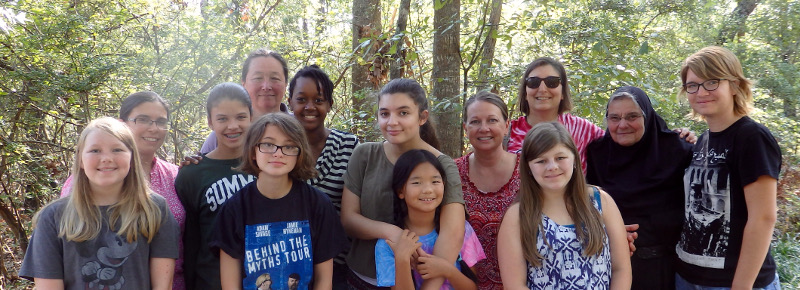
Knowing that our E-Z Go was in desperate need of repair, we asked a friend who had a trailer if he would haul it to our mechanics, which he did. It was tricky getting the E-Z Go on the trailer and securing it in place as it didn't have any brakes, hadn't had for some time. We didn't know that if you don't keep brake fluid in the brake system, water seeps in and causes them to rust. We do now. Locating parts for a 1997 E-Z Go was a challenge, but they persevered and found them. Now our E-Z Go runs much better, but, as it has always been, is cold natured.
Our monastery overflowed with clergy wives at their retreat near the end of
September, fourteen plus one infant. Their topic this year was "The Theotokos". 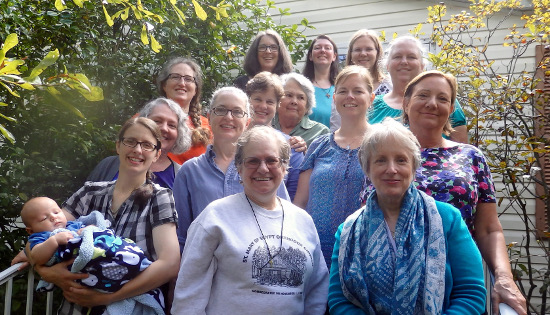 Not having money for speakers, each year they pick a topic, divide it into four or five sub-topics, and ask different members to speak for an hour or so on each. While
technically not a clergy wife, Mother Thecla was asked to speak on "Titles of the
Theotokos". Fr. Adam Hortsman from Saint Anthony the Great Orthodox Church in
Rock Hill, South Carolina, served Liturgy on Sunday for the women. It is always
good when the clergy wives end their retreat with Divine Liturgy.
Not having money for speakers, each year they pick a topic, divide it into four or five sub-topics, and ask different members to speak for an hour or so on each. While
technically not a clergy wife, Mother Thecla was asked to speak on "Titles of the
Theotokos". Fr. Adam Hortsman from Saint Anthony the Great Orthodox Church in
Rock Hill, South Carolina, served Liturgy on Sunday for the women. It is always
good when the clergy wives end their retreat with Divine Liturgy.
With dire warnings of torrential rains and possible flooding before the weekend of October 3rd and 4th, Fr. Thomas Moore of Holy Apostles Orthodox Church in West Columbia, South Carolina, ventured forth and served Liturgy here. About fifteen attended, but everyone was nervous and left shortly after repast. That was the night the heavens opened up and poured eighteen inches on Columbia and points east of us, thus causing major flooding and damage. We, being on the sand hills and usually receiving less rain, only had ten inches. Not having watched the news on Sunday morning, we received two phone calls letting us know that the governor was asking everyone to stay home if possible. That was a rare Sunday, indeed. We did not experience any flooding ourselves, but part of Spinner Lane was a few inches under water. In the weeks after this disaster, friends and family called to see if we were all right and if there was anything they could do to help us. Even now, we are still hearing about the great outpouring of people, both local and from afar who aided those affected by the flood.
The next weekend, a work group from Holy Transfiguration Orthodox Church in Morrisville, North Carolina, were scheduled to come. Having heard of all the flooding and possibly more rain on Saturday, they were ambivalent about traveling, and rightly so. The ones who journeyed here camped out behind the Barne Shoppes. Thinking that this time the weather man might be right, they packed up the tents and camping gear before Matins and breakfast. The sky opened up, and it rained for most of the day. They cleaned the floor-to-ceiling windows that are on three sides of the front porch of the Barne Shoppes, made a good start on painting the ceiling in the Hermitage, and helped clean up the inside of the new building. The children enjoyed using the push broom to sweep the floors of the new building, because they could run fifty feet non stop. They also enjoyed having an excuse to get wet, even when the rain stopped.
The following Monday, a couple came to help with whatever needed doing and continued to paint the ceiling of the Hermitage. While his wife was scheduled to visit the grandchildren for a few days, he decided to return and finish the job. The ceiling is bright and white and makes the Hermitage look much cleaner.
With all the rain, we made an inspection of all of our buildings and found that three of them had roof problems. We knew that the skylights in the doublewide needed sealing, but we found leaks in our warehouse and in the Barne Shoppes. Our roofer came out toward the end of October and fixed everything.
About two years ago, Mother Thecla took weaving lessons from Mary Scott of Serendipity Farm and Studio, now in Leesburg, Florida. For some time, we had been making payments on a used Leclerc Colonial V2 45" eight harness traditional loom. Half the payments came from a dear friend. On October 23-24, Mary delivered it, and we assembled it. Oh, now to have time to weave the blanket that is warped onto the loom.
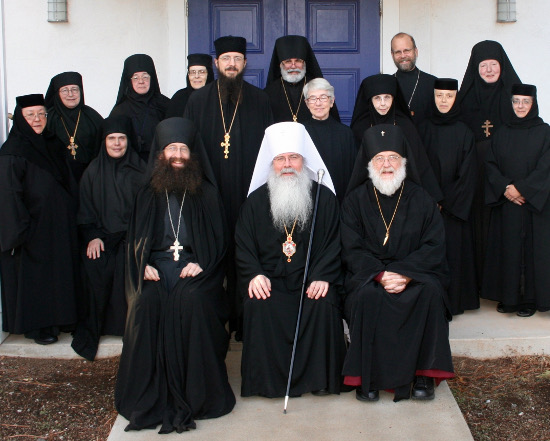
As if October wasn't full enough, the month ended with the Synaxis of the Monastic Superiors which was hosted by the Monastery of Saint John of Shanghai and San Francisco in Menton, California. There were fourteen monasteries represented with Metropolitan Tikon presiding and Archbishop Benjamin, in attendance. It was truly a blessing to be with one another and discuss matters of importance to us and to realize that we share many of the same problems, one of which is dealing with the "ME" culture of today.
For twenty years now, we have loaded up the stuff given to us to sell and schlepped to the Barnyard Flea Market. This year we filled five tables. If we had not had help, we could not have managed it. It was one of our busiest Saturdays ever. At the end of the day, our net proceeds were $777.84 for the building fund. The best part of the day was selling Mother Lyubov's body bag.
You see, when she first entered the monastery, she told us that she brought a new body bag in which to be buried. That way we would not be out the cost of a coffin. We stored it with all the other bags in a plastic container and forgot about it until we ran across it while cleaning out the studio to make room for the loom. Not knowing what else to do with it, we wrote, "Unused Body Bag $5" on a piece of masking tape, placed it on the body bag, and boxed it up with the other items for sale. When flea market day came, we placed it in a predominant spot on one of the tables and watched to see who would buy it. People would pick it up and say, "I've never seen a body bag before." Or, if they did not see the piece of masking tape, they would unfold it and comment, "It's an American body bag. No signs it has been used already." Knowing that it was a body bag, some would ask, "What would we use a body bag for?" At one point, an older man remarked, "I've been coming to flea markets for over thirty years, and never have I seen a body bag for sale!" Around one o'clock that afternoon, a young man who was of a kindred spirit with Mother Lyubov, picked it up, mused about it for several minutes, then said, "I could use it as a sleeping bag, or to protect things on camping trips." He bought it. We hoped that Mother Lyubov was watching and enjoying all this as much as we did.
When Mother Lyubov took her children camping, she placed a body bag on top of the car, filled it with the camping gear that didn't fit in the vehicle, and used the hand holds to tie it to the bumpers. By the way, we buried her in an Orthodox Christian casket made by Daniel Kowalcheck.
Thanksgiving was rather quiet this year. As is our usual, we remembered to give thanks to God with the rest of America, attended Liturgy, and later had a really good meal. It is so important to remember to thank God every day.
Hardly had we finished putting away what was left from the flea market, when we started preparing and packing up items to sell at Saint Nicholas Festival which is held on the first Saturday of December. This year we had enough pears for making wine. It was available at the festival, and there is still some available. After many years of use, we had to purchase a replacement top for our tent. Since it had rained four years running and the tent top leaked, it was time. This year the day was beautiful, a goodly number of people turned out, and sales started early and were brisk. Our jewelry sales were just over $1600. Having purchased wooden toys from a local craftsman, numerous lovers of simple toys snarfed them up. The net income from these sales also went to the building fund. Several people gave us some really nice items to sell with the condition that the proceeds go to the building fund. Little by little, it all adds up.
For about seven years now the refrigerator has made rather loud, farting sounds which is an indication that the compressor is failing. In pricing a replacement refrigerator, we found that it is cheaper to purchase a larger one rather than the small one that fits the space provided for it in the doublewide trailer. This meant taking out part of a decorative wall and a small kitchen cabinet. After waiting several months, the man whom we had asked to do this work finally had the time. Now, when the refrigerator finally dies, we're ready. For twenty years we have needed a larger refrigerator.
Sometime late last fall, five chickens wondered onto our property, discovered the bird seed, and decided to stay. That worked well till we adopted Galicia, a ten-month old border collie, from an individual. We thought that border collies and collies were similar breeds. - Wrong! She chased anything that moved including our cats. It didn't take long for us to realize we had made a mistake and started looking for a suitable home for her which we found through a friend. The cats had three weeks of bad hair days. The chickens went back across the street. Galicia, now Gracie, has a dog-only home with playmates, one of whom is a border collie. Thanks be to God.
We are ever grateful when individuals, couples, families, or groups volunteer to help
with the upkeep of this monastery.
There is so much to do that we keep a
continuous "To Do List".
With all the rain over the past eight months, it has been
difficult to accomplish anything outside. Our list consist of mostly outdoor jobs.
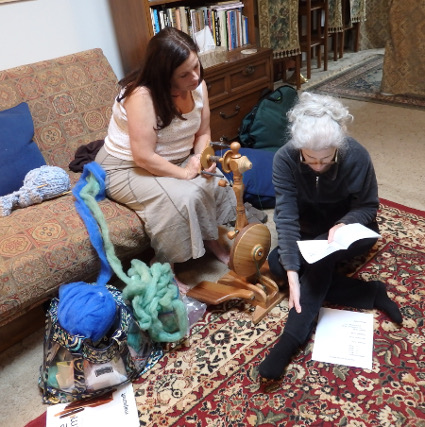 In
addition to the tasks that have been mentioned earlier in this newsletter, a wooden
rocking chair was painted deep blue, our paths through the forest were raked, the
orchard floor was also raked, the paths around the doublewide were cleared several
times, and many other tasks were accomplished.
In
addition to the tasks that have been mentioned earlier in this newsletter, a wooden
rocking chair was painted deep blue, our paths through the forest were raked, the
orchard floor was also raked, the paths around the doublewide were cleared several
times, and many other tasks were accomplished.
Even without a current newsletter, we received many Christmas donations, most of which added to our building fund. While we know that we cannot build this monastery by ourselves and that God inspires many of you to support us in this endeavor, we owe all of you a debt of gratitude and continue to keep you and yours in our prayers.
Knitters met here for a retreat on February 19-20. While seven people were signed up, four attended. The picture shows two of the knitters assembling a spinning wheel. It was a brief time to withdraw from the world, but was greatly appreciated by all.
Since we started our candle business sixteen years ago, we have never been able to keep a stock of the 3/8" tapers, our standard prayer candle. Candle orders abound, and we thank God, whom we know is our sales representative.
February 22nd marked the third anniversary of Mother Lyubov's repose in our Lord. May her memory be eternal.
Pray for vocations.

HIEROMARTYR DIONYSIOS THE AREOPAGITE
October 3rd
(Western Calendar October 9th)
Patron Saint of Lawyers
"The purpose of the whole is the elevation of man to God.
Union with God is the vestibule of truth,
and the unique way to attain the highest truth."
Dionysios the Areopagite
Born in the first century of noble, Athenian parents, Dionysios was highly educated in a manner befitting his station in life and great intellect. He excelled in philosophy, law, astronomy, history, and many other disciplines. As a young man, he journeyed to Helioupolis, Egypt (northeast of Cairo) with other erudite young men to study astronomy. While there, he experienced the darkening of the sun at noon in the middle of the month. Knowing the cycle of solar eclipses and the dates thereof, he realized that this was not in accordance therewith. Dionysios exclaimed, "Either God aileth, or the end is nigh!" Recording the day and time of this event for future reference, he hoped that someday he would learn the cause of this phenomenon.
Dionysios grew to become one of the most learned Athenians of his day. It is said that he surpassed the Epicurean and Stoic philosophers in wisdom. In addition to his nobility and intellect, Dionysios was also renown as an eloquent speaker and highly respected for his integrity throughout Athens. These attributes led to his being elected to the prestigious, nine-membered, high court of Athens who met on the Areopagos (Mars Hill to the Romans).
During Dionysios' time as one of the judges, Paul, the Apostle to the Gentiles, arrived in Athens (Acts 17:15-34). For centuries, men would gather in the marketplace and discuss philosophy at great length and were always interested in new ideas. Not only did Paul preached the Gospel of Christ in the synagogue, but also to the philosophers in the marketplace. They listened. They questioned. However, when Paul spoke of Jesus' rising from the dead, they were incredulous. Therefore, they decided to take him to the Areopagos and let the judges evaluate Paul's strange teachings. Standing in their midst, Paul began to speak of what he had observed in Athens and centered his speech on an altar he had seenthat was inscribed "To the Unknown God". [1]
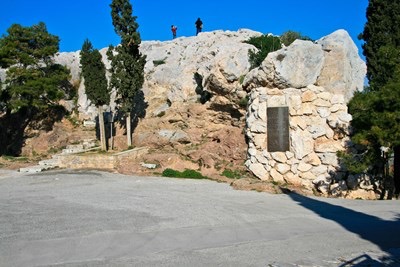
The Areopagos in Athens, Greece
The plaque has Saint Paul's sermon engraved on it .
Paul defined this "Unknown God" as the true God Who made all things, calls all people to repentance, and provides for their salvation through Jesus' death and resurrection. Most of them were skeptical, but stated that they would hear him at another time. Some wanted to hear more of this strange god. Among them were Dionysios and Hierotheus (feastday Oct. 4) the Thesmothete (rule setter) who was also a member of the Areopagos.
Dionysios brought Paul to his house and asked many question about Christ's teachings, His incarnation, His divine dispensation, His passion, His resurrection, and His ascension. When Paul was describing His crucifixion and how the sun hid its rays and darkness covered the earth, Dionysios questioned him as to the date and time of this occurrence. Checking his notes, Dionysios verified that this happened while he was in Helioupolis. Being fully convinced of the truth of Paul's words, Dionysios and his whole household as well as many others believed and were baptized by Paul. Resigning his position as an Areopagite, Dionysios followed Paul in his travels for three years and refers to him as his "chief instructor" in the sixth chapter of his writing, On the Celestial Hierarchy.
Learning that the Theotokos (Mary) was still alive, Dionysios traveled to Jerusalem. Without being told who she was, he knew by her appearance that she was the Mother of God (the Son), full of heavenly grace, purity, and beauty. He had the opportunity to speak with her and was astonished when he heard her God-inspired words which profoundly affected him. He greatly rejoiced at being in her presence and benefitted immensely from his visits with her.
Dionysios remained in Jerusalem for many days where he met James (the Lord's brother), Peter (Foremost of the Apostles), John the Theologian, and many other followers of Christ. Afterwards, Dionysios traveled extensively spreading the Gospel of Christ before returning to Athens to help the church there where Hierotheos had been ordained by Saint Paul as the first Bishop of Athens.
When the Dormition of the Theotokos took place, not only were the Apostles transported on clouds to Jerusalem, but also Dionysios, Hierotheos, Timothy (one of the seventy and later Bishop of Ephesus), and Ignatius the God-Bearer and Bishop of Antioch. All of them were brought there to attend her funeral and her being taken body and soul to heaven by her Son. At her funeral, Hierotheos, being a hymnographer, was divinely inspired to sing hymns to her (fragments of which are to be found in Dionysios' writings). Dionysios himself honors her with the titles "Life-Springing" and "God-Receptive Body".
Over the years, Dionysios learned much from Hierotheos, who had also learned from Saint Paul. Through the Holy Spirit, Saint Dionysios grew spiritually and intellectually which manifested itself in his love of God and others and in his writings. After Hierotheos reposed, Dionysios the Areopagite became the second bishop of Athens. When he heard that Paul was in prison in Rome, he went to visit him and witnessed his beheading as he later recounted to Timothy in a letter. Dionysios shepherded his flock well, and was spoken of as a shepherd of shepherds, a teacher of teachers, and an apostle. Two centuries later, Saint John Chrysostom describes him as a "bird of the Heavens."
At the end of the first century during the reign of Domitian (r. 81-96), Orthodox Christian tradition states that Dionysios suffered martyrdom by burning in Athens. [2]
The Works of Dionysios the Areopagite
The writings of Dionysios the Areopagite that have survived to the present time are On the Celestial Hierarchy, On the Ecclesiastical Hierarchy, On the Divine Names, On Mystical Theology, and Eleven Epistles. The writings which have been lost are On Theological Outlines, On Symbolic Theology, On the Soul, On the Just Judgement of God, On the Objects of Intellect and Sense, and On Divine Hymns.
Western Christian scholars have had a long standing debate as to the author of these books. Until Rev. John Parker who published his translations and findings in 1897, most of these scholars stated that Dionysios the Areopagite, second Bishop of Athens in the first century, could not have been the author of these writings as they were neoplatonic and must have been written by Pseudo-Dionysios who lived in the fifth century. Their assumption was and still is that no one in the first century could have known that which was written. If so, where would he have acquired it? Another argument to deny him authorship was one which stated that he did not quote the church fathers. They also stated that his works were not known till the fifth century.
In Eastern Christendom, Dionysios the Areopagite has always been deemed the author of these writings. First, the idea that "God is not only an unmoved mover, but also moves" is considered heresy by Neoplatonists and Aristotelians alike. Secondly, why would one attribute these works to an unknown person, possibly a Syrian monk of the fifth century?
Thirdly, the Areopagite learned much from the Apostle Paul who was known to have had divine revelations (II Corinthians 12), from his conversations with the Theotokos, and from his contacts with other first generation disciples who personally knew Christ when He walked the earth. Dionysios based his writings on theosis, (the growing in oneness with God through one's own experiences and the experiences of others), not through logic (a mind only approach). His book, On the Celestial Hierarchy., is so detailed that he must have gained his knowledge from Saint Paul, others, and his own personal experiences. Protopresbyter Fr. John Romanides (1927-2001) states, "By experience, the Fathers know that our concepts about God lose all value when we gaze directly at God Himself and behold that reality, which is none other than God Himself."
Fourthly, it is well known that the church fathers of the early centuries of Christianity relied
heavily on Scripture. Dionysios the Areopagite quoted from Scripture over five hundred
times in his writings, and, in so doing, used every book in the Bible except the Epistles of
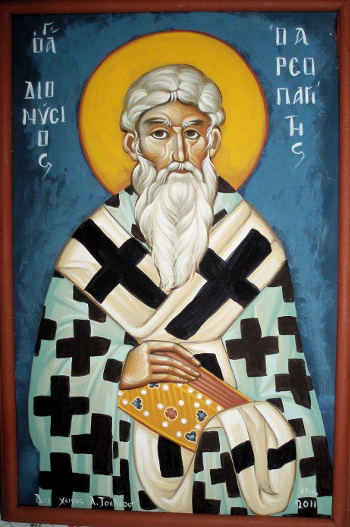 second and third John. Not once does he allude to any person or event beyond the fist
century. He coined Greek words to reflect Christian beliefs, thus paving the way for future
Christian theologians.
second and third John. Not once does he allude to any person or event beyond the fist
century. He coined Greek words to reflect Christian beliefs, thus paving the way for future
Christian theologians.
While Dionysios the Areopagite's writings were virtually unknown in Western Christendom in the early centuries, they were well known among Orthodox Christian scholars in the east. He wrote four letters to Gaius whom John the Theologian addressed in his third Epistle; another two to Polycarp (69-155), later Bishop of Smyrna; and, yet another to Titus a friend of Timothy who was a dear friend of Dionysios. Numerous are those who not only knew his works but quoted and built upon them. Dionysios, Bishop of Alexandria from 248-264, based his Scholia (Commentary) on the works of the Areopagite and wrote to Pope Sixtus II sometime around 250 about these works. Origin (c. 184-253) mentions Dionysios the Areopagite by name. Plotinus (250-270) expresses his writings on the Godhead in the same manner as Dionysios. Jerome (347-420) refers to Dionysios as "a certain Greek one." Saint Maximus the Confessor (580-662) also wrote his Scholia based on the Areopagite's writings. This is a short list.
With the first Christians being Jews who followed Christ and eventually were cast out of the local synagogues, they took their rich Judaic heritage with them and Christianized it as they spread the Gospel of Christ and established churches. As further proof, Saint Dionysios the Areopagite describes a rich liturgical life of the first century churches by 1) the consecrations/ordinations of bishops, priests, and deacons; 2) baptism of the whole family by triple immersion and anointing with holy oil; 3) bishops, with the help of priest(s) and deacon(s), performing baptisms; 4) a formula of Liturgical prayers, both communal and private, for consecrating and partaking of Holy Communion; 5) the use of incense; 6) the stationing of young, unmarried men as look outs at the doors due to persecution; 7) the consecration of monastics.
While in Spain, Lucius Flavius Dexter (late 4th century), a well known statesman, historian, and friend of Jerome, compiled a history of the Christian Church in Spain from 1-450 using the archives of the Church in Toledo. Dexter found an account of a Marcellus Eugenius who was consecrated Bishop of Toledo by Dionysios the Areopagite at Arles (a town in the very south of Gaul). Dionysios gave Marcellus the additional name Timothy, his friend and Bishop of Ephesus who had recently been martyred. Also, he dedicated his book, Divine Names, to him.
Rev. John Parker asserts, "Alexandria became the home of Christian philosophy, but Athens was its birth place." It is most certain that the founders of the Alexandrian School, Pantaenus (c. 120-213) of Athens and Ammonius-Sacus (c. 160-242) of Alexandria, had copies of at least some of Dionysios the Areopagite's books. This is based on a letter, No. 12151-243, that Rev. Parker found in the British Museum which states that Dionysios' works were known shortly after Pantaenus' repose.
Adding to the evidence that Dionysios the Areopagite was indeed the author of these books is Fr. Dumitru Staniloae (1903-1993), a Romanian Orthodox theologian and writer, who translated Dionysios' works into Romanian and fully believed that they were written in the first century by Dionysios the Areopagite and not the Pseudo-Dionysios as Western academia purports. Fr. Dumitru notes that none of the Areopagitic writings defend the Holy Trinity or the hypostatic union of Christ (both divine and human natures in the single person of Christ) and do not address the heresies of Nestorianism (the disunion of the divine and human natures of Christ) or Monophysitism (only one nature in Christ, not two, either wholly divine or only subordinately human). These Christological disagreements were of great importance to the first (325), second (381), third (431), and fourth (451) Ecumenical Councils. Fr. Dumitru also points out the lack of any developments regarding the Holy Trinity based on the writings of Saint Athanasius the Great (c. 297-375), Saint Basil the Great (c. 329-379), or Saint Gregory Nazianzen (329-390) in the Areopagite's writings.
If your interest is sparked, more of Fr. Dumitru Staniloae's defense of the writings being penned by Dionysios the Areopagite can be read at http://www.johnsanidopoulos.com/ 2009/10/apostolic-authorship-of-corpus.html, and/or Rev. John Parker's translations and his arguments in favor of the first century saint can be read at http://sacred-texts.com/chr/ dio/index.htm.
DAMARIS OF ATHENS
October 2nd/3rd
Outside of the Apostle Luke's mention of Damaris in Acts 17:34, " . . . and a woman named Damaris . . .", little is known of her. Since her name follows that of Dionysios the Areopagite, it is generally deduced that she was present when the Apostle Paul was speaking to the Council of Areopagos (Mars Hill) in Athens regarding the altar "To the Unknown God" and how the "Unknown God" was Christ. From Saint Luke it is also known that Damaris converted to Christianity upon hearing the Gospel of Christ. While we are certain that St. Luke wrote the Gospel of Luke (considered to be the Gospel of women) and The Acts of the Apostles, it is understood that St. Luke included her name to show that both men and women had (and continue to have) important roles in establishing and building The Church that Christ founded. Beyond this, there are twenty centuries of speculation by theologians and historians about Damaris.
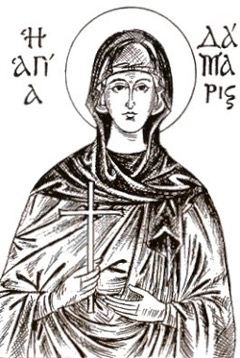
She is most widely thought of as Dionysios' wife. Saint John Chrysostom and Saint Ambrose, both of the 4th century, mention her as his wife. There are manuscripts dating from the late 10th century of an autobiography of Dionysios which have a Greek - Arabic - Georgian- Armenian linage that state, "On that day [Paul] baptized me and my wife and many of the people of Athens, men and women; and from that time my wife Damaris followed the blessed Apostle." [3]
Yet, in 6th century Syriac versions, there is no mention of Damaris. To date, earlier manuscripts have not been found; however, much can be said for oral traditions. Dissenters refute this by claiming that it was common practice at the time to write, "the woman's name, his wife".
As to her status in Athens, it has been posited that she was an influential woman of Athens, a Jewish woman who heard Paul preach in the local synagogue and not on the Areopagos. There are those who argue that Damaris was a noted woman philosopher who was present on the Areopagos with the Council of the Areopagites and others when Paul was propounding on the Gospel of Christ and His crucifixion and resurrection as "The Unknown God." Numerous historians speculate that she was a woman of a high social standing, and, therefore, well educated. Some hypothesize that she was one of the hitaerae (courtesans) who were commonly seen on the streets of Athens and were noted as having long lasting relationships with one man and providing him with intellectual conversations. Ancient Greek culture traditionally dictated that wives were to bear children (legitimate heirs) and live in seclusion at home.
With two thousand years of endless conjecturing , the only thing we truly know about Damaris is found in Acts 17:34. For an extensive accounting of the various postulations on who Damaris was, see J. W. Childers' research paper: https://www.academia.edu/2631352/A_Reluctant_Bride_Finding_a_Life_for_Damaris_of_Athens_Acts_17_34_ . [4]
- There is a tradition that Dionysios erected this altar "To the Unknown God" after his experience in Egypt.
- In Western Christendom, Dionysios the Areopagite and Dionysios of Paris (c. 258) were confused. In 827 a Byzantine manuscript containing the life of the Areopagite was presented to Louis the Pious by an emissary from Constantinople. Later that century, a hagiographer blended the Parisian account of Dionysios (Dennis) of Paris with the account of Dionysios the Areopagite of Athens.
- BHO 255 (Bibliotheca hagiographica orientalis [Société des Bollandistes, eds.; Subsidia hagiographica 10: Brussels: Société des Bollandistes, 1910] 59-60).
- The Ecclesiastical History and the Martyrs of Palestine, Book III.4.10, Eusebius, Trans. Hugh Jackson Lawlor,
and John Ernest Leonard Oulton, SOCR, London, 1954.
The Great Synaxaristes of the Orthodox Church, October, Holy Apostles Convent & Dormition Skete, Buena Vista, Colorado, 2002, pgs. 51-52.
The Lives of the Saints, Volume the Eleventh, October Part I, S. Baring-Gould, John Grant, Edinburgh, 1914.
Patristic Theology, by Protopresbyter John S. Romanides, Uncut Mountain Press, Walla Walla, Washington, 2008.
The Works of Dionysius the Areopagite, trans. Rev. John Parker, John Parker and Co. Oxford, England, 1897.
https://www.academia.edu/2631352/A_Reluctant_Bride_Finding_a_Life_for_Damaris_of_Athens_Acts_17_34_ .
http://www.johnsanidopoulos.com/2009/10/apostolic-authorship-of-corpus.html

BUILDING FUND UPDATE
Having just spoken to our contractor to ask, "What should we do next?", we learned that the next step is roughing in the heating and air conditioning. The reason being that duck work, equipment, etc. is more rigid than plumbing or electrical. The estimate for this portion is $93,500. Presently, we have around $25,000 towards this goal. Please keep the dollars coming. It all adds up as God wills.
IRS LETTERS
If you need an IRS letter from us and did not receive one, please let us know.



Saturday Liturgy Schedule
March 12th at 9am
April 2nd at 9 am
PILGRIMAGE - May 14th at 9am
June 4th at 9am
July 9th at 9am
Matins starts at 8 am.

STAINED GLASS WINDOWS
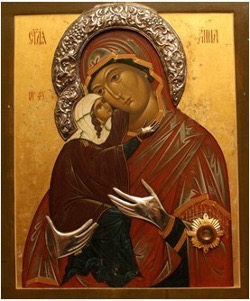
If you've read the newsy part of this letter, you know that people want to see the chapel adorned. Of course the first place they knew this could start happening was the windows. The saints chosen for these windows are Saint Anna with the Theotokos, Saint Martha of Bethany, Saint Mary of Bethany, Saint Thecla, Equal to the Apostles, Saint Lyubov of Rayzan, Fool for Christ, and Saint Olga of Alaska. Each window will cost $8500. Saint Olga has already been paid for and is in the making. Saint Martha has $3000 toward her window. There is another $600 for whomever.
Anyone who wants to purchase a window or donate towards one of the five remaining is encouraged to do so. It will be interesting and fun to see who is next.

FROM MARTHA'S KITCHEN
GRAPE SALAD
Fold together in a large serving bowl:
8 oz. pkg. spreadable blueberry cream cheese
1⁄2 cup plain Greek yogurt
1⁄8 cup simple syrup*
1⁄2 pint whipped cream, whipped with
1 Tablespoon of powder sugar
Fold into above mixture:
1 lb. red seedless grapes, cut in half width wise
1 lb. green seedless grapes, cut in half width wise
1 lb. purple seedless grapes, cut in half width wise
1 cup candied almonds**
*Simple Syrup
In small sauce pan combine 1⁄4 cup of sugar with 1⁄4 cup of water. Add one
cinnamon stick, one vanilla bean split and scraped, and 1⁄2 teaspoon whole cloves.
Cook over medium heat 10 minutes. The rest can be stored in an airtight jar to be
used later.
**Candied Almonds
3 Tablespoons sugar
1 cup slivered almonds
Combine in small skillet until sugar melts and coats almonds. Pour out quickly onto
waxed paper or Silpat.
NOTE: A good way to reuse the shell of the vanilla bean is to rinse it, let it dry, and add it to some sugar so that you can have vanilla flavored sugar to add to tea, coffee, cereal, etc.
by Valerie Selby